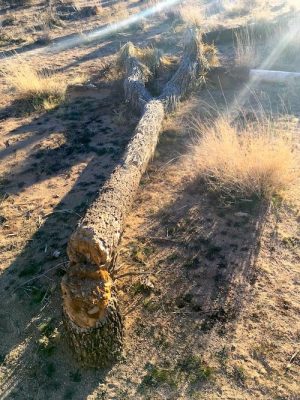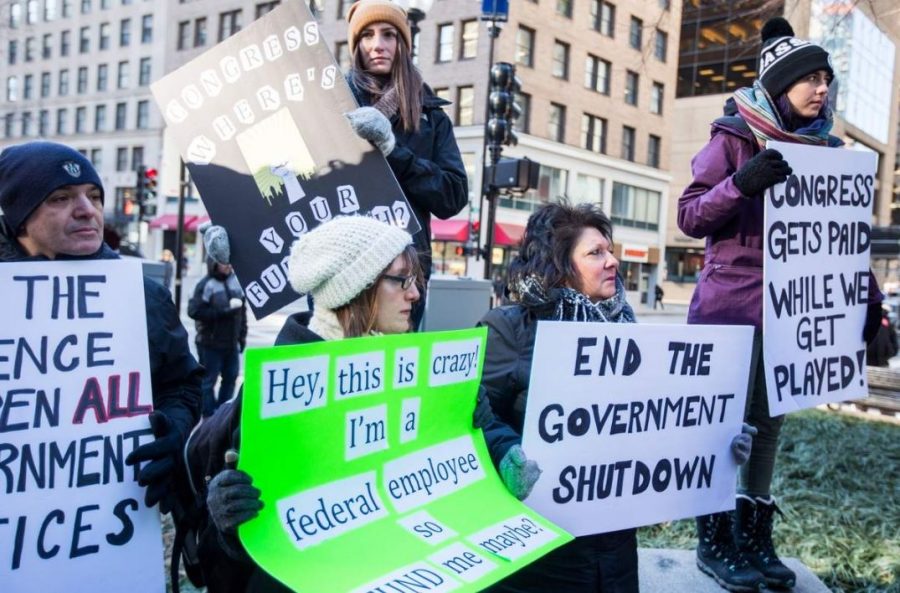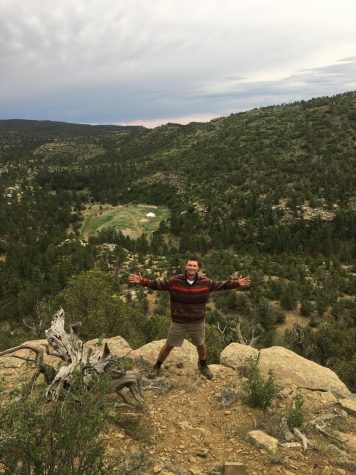Shutdown showdown: A look inside the longest government shutdown
Picture from Tampa Bay Times, Bloomberg photo by Scott Eisen]
Demonstrators hold signs during a protest at Post Office Square in Boston
February 5, 2019
The United States Federal Government recently put a temporary end to the shutdown that became the longest in United States history, lasting 35 days and costing $6 billion.
On Jan. 25, President Donald Trump signed a short-term stop-gap spending bill that would reopen the government temporarily until Feb. 15.
This bill will allow federal employees to return to work but does not contain the $5.7 billion the President wants for his border wall with Mexico. The 800,000 federal workers that missed two paychecks will be repaid in which President Trump said “very quickly or as soon as possible.”
The second longest shutdown in U.S history came in 1995-1996 from December to January when President Bill Clinton and Speaker of the House Newt Gingrich ran into a stalemate over a seven-year budget plan.
It appears that government shutdowns is something that has been a normality for the last few years in American history, but how do these shutdowns happen and why do they take place?
The answer lies within the Congressional Budget and Impoundment Act of 1974 that went into effect in 1976, therefore implementing America’s modern budget process.
Each year, Congress has to pass budget legislation for the next fiscal year that consists of a dozen bills that are distributed among the 12 appropriations subcommittees. If Congress and the President do not pass these bills for the government’s future budget, then the government will be shut down.
In regards to this government shutdown, it began due to the discrepancies between the Democratic and Republican parties on border security, specifically President Trump’s $5.7 billion proposed border wall.
That brings the United States to its current state, where Americans nationwide and worldwide have been affected by this government shutdown.
Government employees have been without pay for the last month as the shutdown resulted in angry employees with pay stubs balancing at zero dollars.

Wisconsin Rep. Mark Pocan tweeted a photo of a government employees paystub after meeting with an air traffic controller
Many workers, such as correctional officers and air traffic controllers stayed at their jobs even after not being paid due to the severity of their work. Workers in those positions are heavily relied upon to ensure the safety of passengers aboard flights, and safety of workers and incarcerated in the prison/jail systems.
National Parks across the states have been impacted heavily by the lack of government employees working to ensure the trash is cleaned up and the forestry and animal life are protected. Several pictures have appeared on social media websites depicting the sight of trash flooding the grounds around campsites.
In one photograph, a government protected tree known as a Joshua tree was seen chopped down. With no one enforcing the regulations in place at the parks, around the U.S. illegal campsites were being put up, and litter was in abundance.
Before closing the Joshua Tree National Park on Jan. 10 (until the shutdown ended), in an interview with National Parks Traveler, Park Superintendent David Smith said, “There are about a dozen instances of extensive vehicle traffic off roads and in some cases into wilderness. We have two new roads that were created inside the park. We had the destruction of government property with the cutting of chains and locks for people to access campgrounds.”
He said, “we’ve never seen this level of out-of-bounds camping. Everyday use area was occupied every evening. Joshua trees were actually cut down in order to make new roads.”

The shutdown not only impacted the country on a national level, but also on a local level. Many in Ashland found themselves facing issues brought on by the shutdown.
The Ashland Symphony Orchestra performed a concert titled “The Music of Star Wars” on Jan. 26 in the Archer Auditorium that would have featured a NASA exhibit from Cleveland that would be featured with the concert.
However, NASA employees were among those that were furloughed, which resulted in the Executive Director of the Ashland Symphony Orchestra, Martha Buckner scrambling to find a new exhibit for the concert.
“On Tuesday, Jan. 15 it occurred to me that NASA Glenn might be shuttered due to the government shutdown and indeed they are and employees are furloughed,” Buckner said. “I had not received any communication from NASA Glenn that the exhibit would not be coming and I had to do my own detective work to figure it out.”
The plans for a new exhibit brought in from the Center of Science and Industry (COSI) were put in place for the concert.
“The symphony will have five COSI Science Spots available from 2 p.m. to 5 p.m. for the public and again from 6 p.m. to 7 p.m. for ticket holders for The Music of Star Wars.”
Buckner also promised two complimentary tickets to government employees that have been furloughed for any of the remaining orchestra concerts in March or April. Employees will have to show their government ID.
Many companies and businesses were giving government employees breaks by passing out food and beverages to the families that had been without paychecks.
Employees of the government were not the only ones in panic, many other citizens were impacted all across the country as well.
Government programs like the Supplemental Nutrition Assistance Program (SNAP) benefits, which sends low-income families money each month to afford the cost of groceries, sent out money for the month of February a couple weeks early. This resulted in confusion and fear for those receiving the checks.
Fear was prevalent throughout Americans furloughed or working without pay as many were wondering where the money would come from for mortgages that were due as well as other bills and expenses.
The U.S. government is facing grave scrutiny for not protecting government employees and allowing families to go without paychecks for an extended, unpredictable period of time. This resulted in protests by those affected by President Trump’s decision.
Several protests took place around Jan. 11 in Boston and Washington D.C. Protesting were hundreds of employees with signs and chants urging the President to end the shutdown.
All of the protests have come to an end now that the government has resumed, however, the shutdown has not been resolved.
So what next? For now, the federal government has currently reopened but only by a stopgap bill that will last until Feb. 15. More bills will have to pass by then in order for the government to avoid another shutdown.




